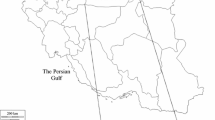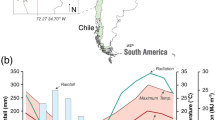Abstract
Valuable teak (Tectona grandis Linn. f.) plantations cover vast areas throughout Southeast Asia. This study sought to increase our understanding of throughfall inputs under teak by analyzing the abiotic and biotic factors governing throughfall amounts and ratios in relation to three canopy phenophases (leafless, leafing, and leafed). There was no rain during the brief leaf senescence phenophase in our study. Leveraging detailed field observations, we employed boosted regression tree (BRT) analysis to identify the primary controls on throughfall amount and ratio during each canopy phenophase. Whereas throughfall amounts were always dominated by rainfall magnitude (as expected), throughfall ratios were governed by a suite of predictor variables during each phenophase. The BRT analysis demonstrated that throughfall ratio in the leafless phase was most influenced (in descending order of importance) by air temperature, rainfall amount, maximum wind speed, and rainfall intensity. Throughfall ratio in the leafed phenophase was dominated by rainfall amount. The leafing phenophase was an intermediate case where rainfall amount, air temperature, and vapor pressure deficit were most important. Our results highlight the fact that throughfall ratios are differentially influenced by a suite of meteorological variables during each canopy phenophase. Abiotic variables, such as rainfall amount and air temperature, trumped leaf area index and stand density in their effect on throughfall ratio. The leafing phenophase, while transitional in nature and short in duration, has a detectable and unique impact on water inputs to teak plantations. Further work is needed to better understand the biogeochemistry of leaf emergence in teak plantations.




Similar content being viewed by others
References
Aertsen W, Kint V, De Vos B, Deckers J, Van Orshoven J, Muys B (2012) Predicting forest site productivity in temperate lowland from forest floor, soil and litterfall characteristics using boosted regression trees. Plant Soil 354:157–172. doi:10.1007/s11104-011-1052-z
Augusto L, Ranger J, Binkley D, Rothe A (2002) Impact of several common tree species of European temperate forests on soil fertility. Ann For Sci 59:233–253. doi:10.1051/forest:2002020
Bringe K, Schumacher CF, Schmitz-Eiberger M, Steiner U, Oerke EC (2006) Ontogenetic variation in chemical and physical characteristics of adaxial apple leaf surfaces. Phytochemistry 67(2):161–170. doi:10.1016/j.phytochem.2005.10.018
Carlyle-Moses DE, Flores Laureano JS, Price AG (2004) Throughfall and throughfall spatial variability in Madrean oak forest communities of northeastern Mexico. J Hydrol 297:124–135. doi:10.1016/j.jhydrol.2004.04.007
Carlyle-Moses DE, Lishman CE, McKee AJ (2014) A preliminary evaluation of throughfall sampling techniques in a mature coniferous forest. J For Res 25(2):407–413. doi:10.1007/s11676-014-0468-8
Cools N, Vesterdal L, De Vos B, Vanguelova E, Hansen K (2014) Tree species is the major factor explaining C:N ratios in European forest soils. For Ecol Manage 311:3–16. doi:10.1016/j.foreco.2013.06.047
De’ath G (2007) Boosted trees for ecological modeling and prediction. Ecology 88:243–251. doi:10.1890/0012-9658(2007)88[243:BTFEMA]2.0.CO;2
Elith J, Leathwick JR, Hastie T (2008) A working guide to boosted regression trees. J Anim Ecol 77:802–813. doi:10.1111/j.1365-2656.2008.01390.x
Herbst M, Rosier P, McNeil DD, Harding RJ, Gowing DJ (2008) Seasonal variability of interception evaporation from the canopy of a mixed deciduous forest. Agric For Meteorol 148:1655–1667. doi:10.1016/j.agrformet.2008.05.011
Herwitz SR (1987) Raindrop impact and water flow on the vegetative surfaces of trees and the effects on stemflow and throughfall generation. Earth Surf Proc Land 12(4):425–432. doi:10.1002/esp.3290120408
Herwitz SR, Slye RE (1995) Three-dimensional modeling of canopy tree interception of wind-driven rainfall. J Hydrol 168:205–226. doi:10.1016/0022-1694(94)02643-P
Holst T, Hauser S, Kirchgäβner A, Matzarakis A, Mayer H, Schindler D (2004) Measuring and modelling plant area index in beech stands. Int J Biometeorol 48:192–201. doi:10.1007/s00484-004-0201-y
Kato H, Onda Y, Nanko K, Gomi T, Yamanaka T, Kawaguchi S (2013) Effect of canopy interception on spatial variability and isotopic composition of throughfall in Japanese cypress plantations. J Hydrol 504:1–11. doi:10.1016/j.jhydrol.2013.09.028
Keim RF, Skaugset AE, Weiler M (2005) Temporal persistence of spatial patterns in throughfall. J Hydrol 314(1–4):263–274. doi:10.1016/j.jhydrol.2005.03.021
Kimmins JP (1973) Some statistical aspects of sampling throughfall precipitation in nutrient cycling studies in British Columbian coastal forests. Ecology 54:1008–1019. doi:10.2307/1935567
Koch K, Barthlott W (2009) Superhydrophobic and superhydrophilic plant surfaces: an inspiration for biomimetic materials. Phil Trans R Soc A 367:1487–1509. doi:10.1098/rsta.2009.0022
Krämer I, Hölscher D (2009) Rainfall partitioning along a tree diversity gradient in a deciduous old-growth forest in Central Germany. Ecohydrol 2:102–114. doi:10.1002/eco.44
Krishnapillay B (2000) Silviculture and management of teak plantations. Unasylva 201:14–21
Kume T, Tanaka N, Yoshifuji N, Tantasirin C, Igarashi Y, Suzuki M, Hashimoto S (2013) Soil respiration in response to year-to-year variations in rainfall in a tropical seasonal forest in northern Thailand. Ecohydrol 6:134–141. doi:10.1002/eco.1253
Levia DF, Frost EE (2006) Variability of throughfall volume and solute inputs in wooded ecosystems. Prog Phys Geog 30(5):605–632. doi:10.1177/0309133306071145
Levia DF, Keim RF, Carlyle-Moses DE, Frost EE (2011) Throughfall and stemflow in wooded ecosystems. In: Levia DF, Carlyle-Moses DE, Tanaka T (eds) Forest hydrology and biogeochemistry: synthesis of past research and future directions (Ecological Studies Series, No. 216). Springer, Heidelberg, pp 425–443. doi:10.1007/978-94-007-1363-5_21
Llorens P, Oliveras I, Poyatos R (2003) Temporal variability of water fluxes in a Pinus sylvestris forest patch in Mediterranean mountain conditions. In: Hydrology in Mediterranean and semi-arid regions (IAHS Publ, No., 278). IAHS Publications, Wallingford, pp 101–105
Loescher HW, Powers JS, Oberbauer SF (2002) Spatial variation of throughfall volume in an old-growth tropical wet forest. J Trop Ecol 18:397–407. doi:10.1017/S0266467402002274
Loustau D, Berbigier P, Granier A, Moussa F (1992) Interception loss, throughfall and stemflow in a maritime pine stand. I Variability of throughfall and stemflow beneath the pine canopy. J Hydrol 138:449–467. doi:10.1016/0022-1694(92)90130-N
Maass J, Vose JM, Swank WT, Martínez-Yrízar A (1995) Seasonal changes of leaf area index (LAI) in a tropical deciduous forest in west Mexico. For Ecol Manage 74:171–180. doi:10.1016/0378-1127(94)03485-F
Macinnis-Ng CMO, Flores EE, Müller H, Schwendenmann L (2012) Rainfall partitioning into throughfall and stemflow and associated nutrient fluxes: land use impacts in a lower montane tropical region of Panama. Biogeochemistry 111:661–676. doi:10.1007/s10533-012-9709-0
Marschner H (1995) Mineral nutrition of higher plants. Academic, San Diego
Martin MP, Wattenbach M, Smith P, Meersmans J, Jolivet C, Boulonne L, Arrouays D (2011) Spatial distribution of soil organic carbon stocks in France. Biogeosciences 8:1053–1065. doi:10.5194/bg-8-1053-2011
McClain ME, Boyer EW, Dent CL, Gergel SE, Grimm NB, Groffman PM, Hart SC, Harvey JW, Johnston CA, Mayorga E, McDowell WH, Pinay G (2003) Biogeochemical hot spots and hot moments at the interface of terrestrial and aquatic ecosystems. Ecosystems 6(4):301–312. doi:10.1007/s10021-003-0161-9
Nanko K, Hotta N, Suzuki M (2006) Evaluating the influence of canopy species and meteorological factors on throughfall drop size distribution. J Hydrol 329(3–4):422–431. doi:10.1016/j.jhydrol.2006.02.036
Nanko K, Hudson SA, Levia DF (2014) Differences in throughfall drop size distributions in the presence and absence of foliage. Hydrol Sci J In review
Peterson DL, Rolfe GL (1979) Determining sample size in throughfall studies. For Sci 25:582–584
Raat KJ, Draaijers GPJ, Schaap MG, Tietama A, Verstraten JM (2002) Spatial variability of throughfall water and chemistry and forest floor water content in a Douglas fir forest stand. Hydrol Earth Syst Sci 6(3):363–374. doi:10.5194/hess-6-363-2002
Ridgeway G (2013) gbm: Generalized boosted regression models. R package version 2.1
Ritter A, Regalado CM (2010) Investigating the random relocation of gauges below the canopy by means of numerical experiments. Agric For Meteorol 150(7–8):1102–1114. doi:10.1016/j.agrformet.2010.04.010
Robson AJ, Neal C, Ryland GP, Harrow M (1994) Spatial variations in throughfall chemistry at the small plot scale. J Hydrol 158:107–122. doi:10.1016/0022-1694(94)90048-5
Shinohara Y, Onozawa Y, Chiwa M, Kume T, Komatsu H, Otsuki K (2010) Spatial variations in throughfall in a Moso bamboo forest: sampling design for the estimates of stand-scale throughfall. Hydrol Process 24(3):253–259. doi:10.1002/hyp.7473
Staelens J, De Schrijver A, Verheyen K, Verhoest NEC (2006) Spatial variability and temporal stability of throughfall water under a dominant beech (Fagus sylvatica L.) tree in relationship to canopy cover. J Hydrol 330:651–662. doi:10.1016/j.jhydrol.2006.04.032
Staelens J, De Schrijver A, Verheyen K (2007) Seasonal variation in throughfall and stemflow chemistry beneath a European beech (Fagus sylvatica) tree in relation to canopy phenology. Can J Forest Res 37(8):1359–1372. doi:10.1139/X07-003
Stogsdill WR, Wittwer RF, Hennessey TC, Dougherty PM (1989) Relationship between throughfall and stand density in a Pinus taeda plantation. For Ecol Manage 29:105–113. doi:10.1016/0378-1127(89)90059-5
Tanaka N, Kuraji K, Tantasirin C, Takizawa H, Tangtham N, Suzuki M (2011) Relationships between rainfall, fog and throughfall at a hill evergreen forest site in northern Thailand. Hydrol Process 25(3):384–391. doi:10.1002/hyp.7729
Vrugt JA, Dekker SC, Bouten W (2003) Identification of rainfall interception model parameters from measurements of throughfall and forest canopy storage. Water Resour Res 39:1251. doi:10.1029/2003WR002013
Wang Q, Tenhunen J, Granier A, Reichstein M, Bouriaud O, Nguyen D, Breda N (2004) Long-term variations in leaf area index and light extinction in a Fagus sylvatica stand as estimated from global radiation profiles. Theor Appl Climat 79:225–238. doi:10.1007/s00704-004-0074-3
Wang H, Shi H, Li Y, Yu Y, Zhang J (2013) Seasonal variations in leaf capturing of particulate matter, surface wettability and micromorphology in urban tree species. Front Environ Sci Eng 7(4):579–588. doi:10.1007/s11783-013-0524-1
Yoshifuji N, Komatsu H, Kumagai T, Tanaka N, Tantasirin C, Suzuki M (2011) Interannual variation in transpiration onset and its predictive indicator for a tropical deciduous forest in northern Thailand based on 8-year sap-flow records. Ecohydrol 4:225–235. doi:10.1002/eco.219
Yoshifuji N, Igarashi Y, Tanaka N, Tanaka K, Sato T, Tantasirin C, Suzuki M (2014) Inter-annual variation in the response of leaf-out onset to soil moisture increase in a teak plantation in northern Thailand. Int J Biometeorol 58:2025–2029. doi:10.1007/s00484-013-0784-2
Zimmermann A, Zimmermann B (2014) Requirements for throughfall monitoring: the roles of temperate scale and canopy complexity. Agric For Meteorol 189–190:125–139. doi:10.1016/j.agrformet.2014.01.014
Zimmermann A, Zimmermann B, Elsenbeer H (2009) Rainfall redistribution in a tropical forest: spatial and temporal patterns. Water Resour Res 45, W11413. doi:10.1029/2008WR007470
Acknowledgments
This work was funded by the Core Research for Evolutional Science and Technology (CREST) program of the Japan Science and Technology (JST) Agency, the Ministry of Education, Culture, Sports, Science and Technology in Japan through a project titled “Program for risk information on climate change”, and Grant-in-Aid for Scientific Research (#23405028, #24405031, #23780161, #24310018, #22780139). We are grateful to Mika Kawamoto for setting up throughfall plot A of this study and also to graduate students from Faculty of Forestry, Kasetsart University, for their assistance in the field. We would like to thank Suwan Pakrat and Srinuan Tunjai for their daily measurements of rainfall and throughfall. David Legates is kindly acknowledged for his input regarding spatial statistics. Finally, we also would like to acknowledge Forestry Industrial Organization (FIO) in Thailand for kind consideration of our research.
Author information
Authors and Affiliations
Corresponding author
Rights and permissions
About this article
Cite this article
Tanaka, N., Levia, D., Igarashi, Y. et al. Throughfall under a teak plantation in Thailand: a multifactorial analysis on the effects of canopy phenology and meteorological conditions. Int J Biometeorol 59, 1145–1156 (2015). https://doi.org/10.1007/s00484-014-0926-1
Received:
Revised:
Accepted:
Published:
Issue Date:
DOI: https://doi.org/10.1007/s00484-014-0926-1




